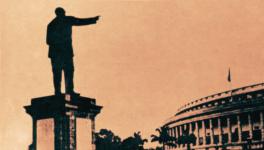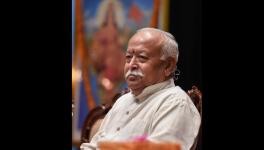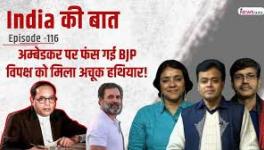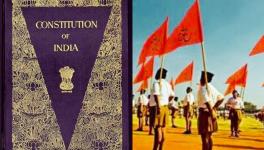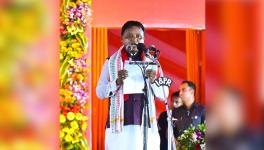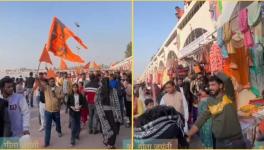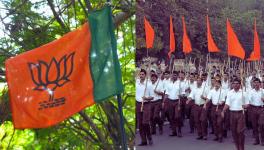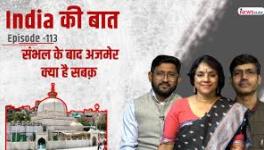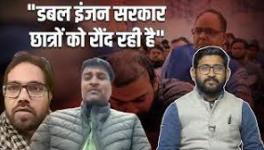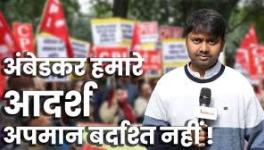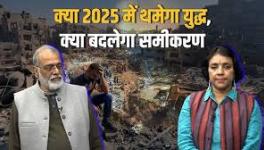What’s Stopping Modi From Visiting Ajmer Sharif, Offering ‘Chaadar’ Himself?
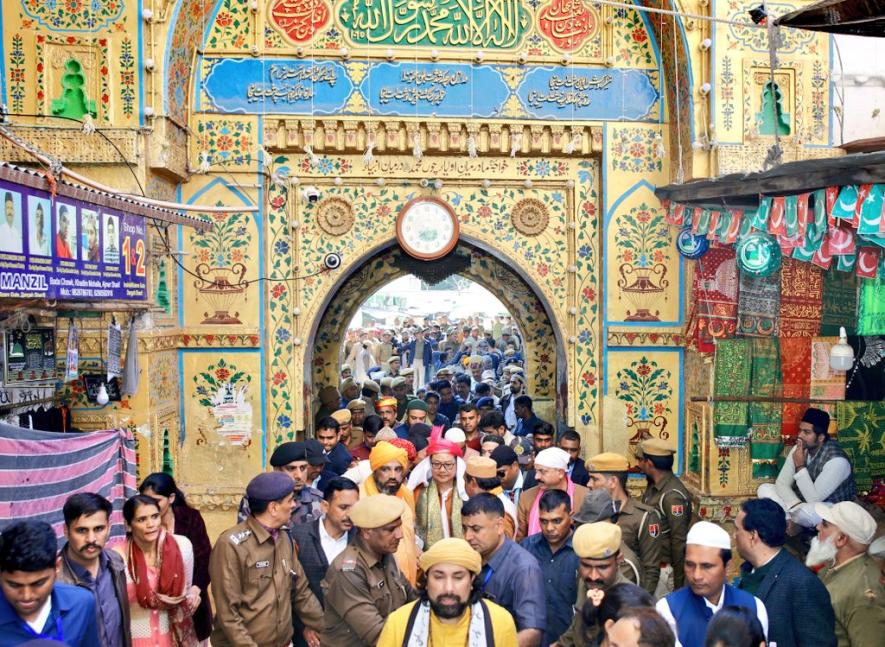
Minister of Minority Affairs Kiren Rijiju at the Ajmer Sharif Dargah to offer 'chaadar' sent by PM Modi. (Image Credit: @KirenRijiju X)
On January 8, Urs of 13th century Sufi saint Khwaja Moinuddin Chishti was observed at Ajmer Sharif. For the past few years, a ceremonial ‘chaadar’ (sheet of cloth) is spread on the tomb of the saint on behalf of Prime Minister Narendra Modi.
For observing Urs, people of the entire sub-continent assemble at Ajmer Sharif, cutting across religious lines. This year, 125 Pakistani pilgrims are said to have visited the place. The dargah (shrine) generally draws a huge crowd throughout the year.
The decision by Modi to offer a chaadar in Ajmer Sharif has acquired an added dimension this year because of the new claims being made by Hindutva forces. To achieve their long-standing demand, the saffron camp has now reached the doors of the judiciary. Vishnu Gupta, the national president of Hindu Sena, has raised a claim that there was a temple beneath the dargah.
A section of the Hindutva forces has, therefore, vehemently opposed this gesture of the Prime Minister. They feel it wasn't proper of Modi to have sent ‘chaadar’ for the dargah before the ‘dispute’ on whether it was a shrine or temple, had been settled.
On Friday, January 3, Union Minister of Minority Welfare Kiren Rijiju and National President of the ruling Bharatiya Janata Party’s Minority Morcha, Jamal Siddique, spread the chaadar sent by Modi at the mazaar (tomb) and read out his message. The Prime Minister said, ‘Down the ages our pirs, fakirs and spiritual heads have enlightened our lives through their philanthropist values. Khwaja Moinuddin Chishti has left through his works undisputably the best examples of service, pity and humanity”.
Sufi saint Moinuddin Chishti, better known as ‘Garib Nawaz’ or the ‘friend of the distressed’ has been described by many historians as an avowed preacher of equality for the human race, irrespective of creed or faith. Everyone, irrespective of caste, creed or gender has a right of access to his tomb. This dargah is known for religious harmony in the Indian sub-continent.
This year, while the Urs was being observed, Hindutva forces have raised a furore by claiming the Ajmer dargah, along with some other mosques, were temples. Immediately after the demolition of Babri mosque (1992), the Vishwa Hindu Parishad had vociferously declared, ‘Yeh to sirf jhanki hayn, Kashi Mathura baki hai', meaning thereby that it was only a beginning and Kashi and Mathura were still left. The realisation of that slogan has already started.
After Hindutva forces started knocking the doors of the courts on the ‘disputes’ over the Gyanvapi mosque at Varanasi or Shahi Idgah mosque at Mathura, they have gradually made their list longer. They are claiming that the mosques were built after demolishing Hindu temples.
The Muslim society does not outrightly reject the historic reality regarding building of some mosques over demolished temples. Their opposition is over the programmes of avenging the misdemeanours of some Sultans or Nawabs committed hundreds of years ago.
A riot over a similar claim regarding the Jama Masjid at Sambhal in Uttar Pradesh has already cost four lives.
The Supreme Court’s ruling settling the 500-year-old dispute over the Ram Janmabhoomi-Babri Masjid has emboldened the saffron brigade to rush to the courts for a favourable verdict regarding their claims. Unlike in the case of the Ayodhya dispute, now they don’t want to embarrass the government by placing their demands before the administration.
Interestingly, Rashtriya Swayamsevak Sangh (RSS) chief Mohan Bhagwat spoke up only after the search for temples one after another beneath the mosques had started. Two years before when the dispute over Gyanvapi mosque peaked, Bhagwat denied any link of Sangh Parivar with the Gyanvapi claim. But that didn't quite bring an end to such searches.
The heightened speed with which Hindutva forces are moving on several mosques in Uttar Pradesh has raised apprehensions that if favourable court verdicts are not received, it’s not impossible that the situation might turn the Babri way. The Ayodhya ruling also raised hopes in the Hindutva forces that they can bank on the judiciary.
Bhagwat said some people were “trying to project themselves as leaders of the Hindus”. It's not exactly clear who the Sangh chief has hinted at. Just a year earlier, on January 22, 2023, during the inauguration of the Ram Mandir at Ayodhya, it was observed how Ram Janmabhoomi was being turned into ‘Modi Nagar’ and ‘Yogi Pith’. Many devotees of Lord Rama who were on a pilgrimage to the newly built temple openly expressed their displeasure that a religious festival was converted into an exhibition of political muscle.
Yogi Adityanath, the UP Chief Minister, has contradicted Bhagwat and has counterposed his views by giving out the message of “keeping alive the temple-mosque disputes” in the name of “recapturing tradition and revisiting history”. Many sadhus and saints have voiced their support to Yogi. Many observers feel that a schism has developed in the saffron camp comprising BJP, RSS and their likes, with Bhagwat trying to distance himself from the hard Hindu chauvinistic line.
This, however, doesn't seem likely. It needs to be kept in mind that RSS is set to observe its centenary in the current year. This, therefore, seems like a well-orchestrated RSS strategy of utilising the opportunity of the centenary year to try and establish links with non-Hindus, including Muslims. As a part of that strategy, Bhagwat, in the recent past, has stressed more than once that Indian Muslims and Hindus “are like brothers and sisters; their DNA is one and the same.”
This message of Bhagwat might appear to be for amity among religious communities, but in reality, it is actually part of the narrative of cultural nationalism propagated by the RSS, of which Hindutva is the main fulcrum. In reality, Bhagwat wants to project the Sangh, in its centenary year, as the sole controlling or regulatory organisation in the country’s religious sphere.
Even if one agrees, for argument's sake, that Modi’s decision to send a chaadar to Ajmer Sharif was a move to strengthen communal harmony, one would like to know what comes in the way of Modi to visit the dargah? Why doesn't he himself spread the chaadar? Why don't he and his government speak their minds on the claims of finding a temple under every mosque? Why can't the government clarify and declare that it would implement the Places of Worship Act 1991 in letter and spirit?
The people of this country did not elect Bhagwat. The safety of the minorities and their places of worship as well as the freedom of religion can't be secured on his words and whims; these merit an unambiguous and unwavering stand from the government.
Getting back to the issue of Khwaja Moinuddin Chisti's dargah. It's difficult to say who among the Hindutvadis, leave alone Modi, has ever visited this shrine. Atal Bihari Vajpayee being an exception.
It's strange that the present Prime Minister visited many mosques in Arab countries while being on a state visit to those places, but there is no such precedent inside the country. He paid a visit to the Sheikh Zayed Grand Mosque during his visit to the United Arab Emirates in 2015. But he didn't go to the century-old Cheraman Juma Mosque in Kerala despite making a promise. He, however, presented a model of the same masjid to the King of Saudi Arabia on his visit there next year. In 2018, Modi went to the Istiqlal Mosque at Jakarta in Indonesia. The same year, he visited Chulia Mosque in Singapore and Sultan Qaboos Mosque, in Oman. In 2023, he visited Al-Hakim Mosque in Egypt.
One mega project of the Modi government is the development of a temple corridor. His government has transformed several places of worship, including Kashi Vishwanath Temple in Varanasi, Mahakal Temple in Ujjain, Jagannath Temple in Puri etc.
The Gyanvapi mosque is quite close to the Vishwanath Temple in Kashi, the Prime Minister’s Lok Sabha constituency. On at least one occasion, Modi spent a substantial period of time in the temple on his birthday, but never bothered to catch a glimpse of the adjacent mosque. It is doubtful if any of his successors would ever be able to match Modi's record of pilgrimage while in office. Inspired by the Prime Minister, his cabinet colleagues, too, have also made it compulsory to include, in their itineraries for official tours, visits to temples.
So, why is the same Prime Minister hesitant to visit the places of worship of Muslims in his own country? We have heard his slogan ‘Sabka Sath’ and have also listened to his words about his “boyhood friend Abbas” who was brought up by Modi’s family after the untimely demise of his father. Modi may not have any personal grouse against Muslims, but has the political compulsion of maintaining a distance that suits his party’s strategy. He is always chased by an apprehension lest he and his party are also accused of minority appeasement.
For, arousing Hindutva sentiments, hatred and antagonism to Muslims are the principal weapons in BJP’s armoury. From Gujarat Chief Minister to Prime Minister, Narendra Modi has played his cards proficiently in both the roles. During the 2024 Lok Sabha election campaign, he beat his own record and stooped to much lower depths. That he is the Prime Minister of a large nation like India, having a population of more than 140 crore, is possibly not kept in mind when he is electioneering for his party.
The writer is Executive Editor, The Wall, and former Senior Editor, Times of India. The views are personal.
Get the latest reports & analysis with people's perspective on Protests, movements & deep analytical videos, discussions of the current affairs in your Telegram app. Subscribe to NewsClick's Telegram channel & get Real-Time updates on stories, as they get published on our website.









